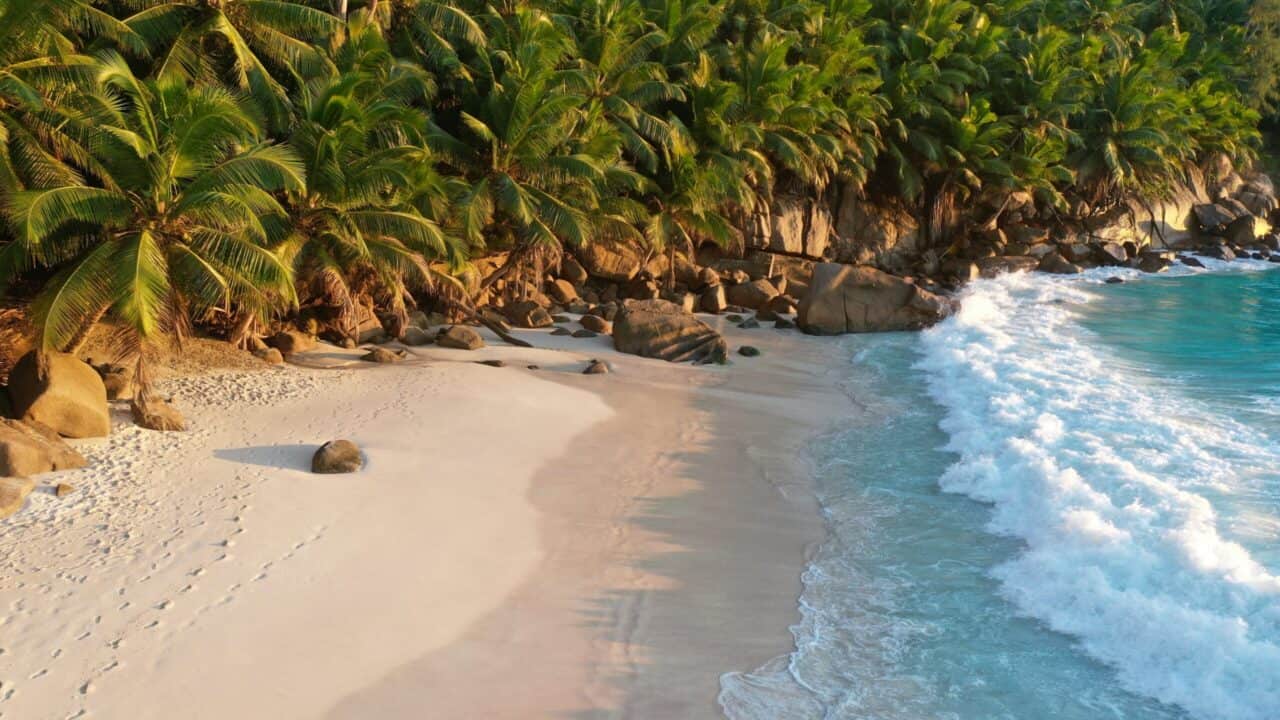Best time to Travel & Climate in Seychelles
Written by Editor on 2nd February 2025
Best time to travel & climate in Seychelles
One of the most common questions we get is – ‘When’s the best time to visit Seychelles?’ And honestly? It all depends on you – your plans, your vibe, and why you’re heading to our island paradise in the first place. Of course, the weather plays a big role too! While Seychelles has a pretty dreamy climate year-round, knowing what to expect can make your trip even smoother.
Seychelles weather doesn’t follow the typical African forecast – it’s got its island mood. That’s why we’ve put together this guide using real experience (and years of sky-watching!) to help you understand the patterns and plan like a pro.

Seychelles Weather Guide – What to Expect All Year Round
Located in the western Indian Ocean, Seychelles enjoys a tropical climate that’s warm, humid, and pretty much summer all year long. Temperatures generally sit between 24°C and 32°C, depending on the season—but let’s break it down so you know exactly what to expect.
Southeast Trade Winds (Southeast Monsoon): May to September
This is Seychelles’ cooler, drier season—especially peaking around July and August. Expect temps between 24°C and 28°C, and trade winds ranging from 19–37 km/h. With these breezes, the sea can get a bit choppy, so if you’re planning to island-hop, flying might be a better choice than the ferry.
But it’s not all wind and waves—this is the best time for hiking, thanks to the cooler air and lower chances of rain. It’s also a great season for sailing, kitesurfing, and any activity that benefits from those awesome ocean swells. Just keep in mind, with climate change stirring things up, Seychelles’ weather can be a bit unpredictable—surprise rain and gusty winds are always a possibility!

Pre-Northwest Monsoon: Mid-September to November
As the winds start to calm down and shift direction, you’ll notice warmer, gentler breezes. This transition period brings clearer skies, calmer seas, and great underwater visibility—perfect for snorkelling, diving, and fishing. It’s also a beautiful time for watersports and even skydiving over the islands!
Northwest Trade Winds (Northwest Monsoon): December to March
This is the warmest and wettest time of the year, with temperatures around 28°C to 32°C. December and January see the most rainfall, but in return, the vegetation is lush and vibrant, and the winds stay mostly light at around 15–22 km/h.
Despite being cyclone season in the region, don’t worry—Seychelles sits safely outside the cyclone belt (that’s more of a Mauritius and Madagascar thing). So while you might get a few heavy showers, you’re still in for warm temps and tropical vibes.

Quick Tip:
The inner islands, with their dramatic granite peaks rising up to 900m, have their own little microclimates. So even on the same day, you might see sunshine in one bay and a passing shower in another—pack accordingly and embrace the tropical rhythm!
Pre-Southeast Monsoon: End of March to Mid-May
Looking for the calmest seas of the year? This is your moment. From late March through April to mid-May, the winds mellow out as they prepare to change direction, making it a dream season for snorkelling, diving, and soaking in those breathtaking, crystal-clear waters.
It’s also a fantastic time for fishing, paddleboarding, and all kinds of watersports. And if you’re up for something thrilling, skydiving is on offer too—what better way to see the islands?
Just one tip: the sun’s out in full force, so make sure to stay sun-safe while enjoying all that tropical goodness.
Hours of Daylight throughout the year.
| Hours of | Jan | Feb | Mar | Apr | May | Jun | Jul | Aug | Sep | Oct | Nov | Dec |
|---|---|---|---|---|---|---|---|---|---|---|---|---|
| Daylight | 12.4h | 12.3h | 12.1h | 12.0h | 11.9h | 11.9h | 11.9h | 12.0h | 12.1h | 12.2h | 12.3h | 12.4h |
Seasonal Seaweed
The tropical trade winds not only define the seasons in Seychelles, but they also determine where the seaweed drifts. Although naturally occurring and harmless, beached marine algae can detract from otherwise picture-perfect coastal scenes, and make swimming a little less pleasant, so its seasonal location may affect the area in which you’d prefer to stay.
Generally speaking, from May to September, the cooler, drier, southeast trade winds bring lively seas to southwest Mahé and result in seaweed being washed up onto the beaches of Praslin’s south coast.
Conversely, from October to April, the calm, warm, northwest trade winds litter Praslin’s Côte d’Or beaches with seaweed, and waves and currents are strong on Mahé’s northwest coast, such as at Beau Vallon. The presence of seaweed is more likely on Praslin’s lengthy coastal stretches than in the coves of Mahé and La Digue.
As weather patterns become less predictable, it is worth remembering that distances on these islands are short, so should the wind result in seaweed being on your closest beach, it’s never very far to nearby beaches without seaweed.
Inside Seychelles is your guide to what’s on in Seychelles, where to go in Seychelles, and what to do in Seychelles
Seychelles Travel Information
At Inside Seychelles, you can get all your Travel Information. What Airlines travel to Seychelles and how to get around the islands. See the Latest Entry Requirements and what is the Customs Formalities for Seychelles.
Plan the Best time to travel & read about the climate in Seychelles.
Have a look at the history and culture of Seychelles, the must-try food and drink, and what to pack in your suitcase. Read about Seychelles’s nature and wildlife, along with ‘Country Quick facts’ compiled by our travel experts. The only way you could possibly learn more is by embarking on your journey and discovering Seychelles for yourself.











